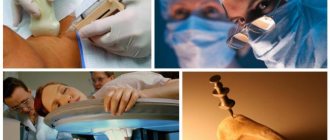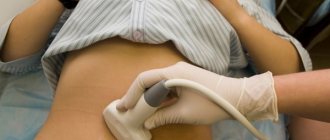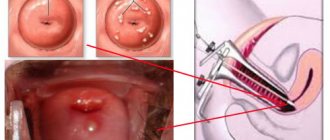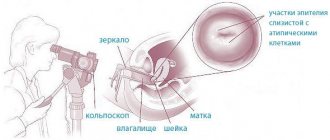Uterine prolapse is a pathological condition in which the organ changes its position, namely, it descends, moving towards the exit of the vagina. In severe cases, when the uterus is visible from the outside, doctors talk about organ prolapse.
Previously, little was known about these diseases. Firstly, almost half of the patients are over 60 years old, and they usually do not go to the doctor until serious symptoms appear. Secondly, 10–20 years ago the best way to treat uterine prolapse and prolapse was its complete removal.
Now the attitude towards women's health has changed dramatically. Giving birth after 40 will no longer surprise anyone, so it is important to maintain the health of the reproductive system. New diagnostic methods, conservative and surgical treatment options have emerged. Prolapse and prolapse of the uterus is no longer considered a disability and has become only a reason to consult a doctor in a timely manner in order to avoid serious health consequences.
- Uterine prolapse - what can be done at home?
What is prolapse and prolapse of the uterus and its cervix?
First you need to understand the terms that doctors use to describe pathology.
Prolapse of the uterus, also called prolapse, is a displacement of the organ downward towards the entrance to the vagina. In this case, the cervix is in its anatomical place. The pathology can be treated conservatively or surgically depending on the stage.
Prolapse of the cervix occurs simultaneously with the prolapse of the organ itself and is not a separate pathology. Essentially, these are the same thing, which is why doctors do not use this term to describe the degree of prolapse.
Prolapse of the uterine wall - this term is used when it is necessary to emphasize which of the surrounding organs are more affected by prolapse. When the anterior wall subsides, the load falls on the bladder. Symptoms include urinary incontinence and leakage - first under stress, and then at rest. After visiting the toilet, a woman experiences feelings of incomplete emptying of the bladder and frequent repeated urges. Without treatment, cystitis and urethritis develop. Prolapse of the posterior wall of the uterus leads to protrusion of the anterior wall of the rectum. The main symptom is problems with bowel movements.
The threat of uterine prolapse is a stage II–III condition that occurs in the absence of treatment or ineffective therapy.
Uterine prolapse is an advanced stage of prolapse, when the cervix is already, at a minimum, at the exit of the vagina and visible from the outside. As the pathology progresses, the entire body of the organ appears in the perineum, and protrusion of the vaginal walls occurs. The disease can only be treated surgically.
Symptoms of uterine prolapse
In the early stages of the disease, treatment is easier and more effective, so it is important not only to know what cervical prolapse looks like in the photo, but also to study the signs of the disease. The problem with diagnosing the pathology is that women in the early stages attribute the manifestation of the disease to fatigue, menstruation, or an uncomfortable position. Many people tend to ignore problems until the signs of uterine prolapse leave no doubt. In these cases, uterine prolapse occurs and the only treatment left is surgical treatment.
When the uterus prolapses, the following symptoms may appear:
- nagging pain in the area of the ovaries, mild at first, then progresses. At first, symptoms appear only after sitting for a long time; in a supine position, the pain subsides. Over time, the pain syndrome intensifies; violation of defecation and urination;
- discomfort and pain during sexual intercourse;
- sensation of a foreign body in the vagina;
- menstruation becomes heavy and painful.
As it progresses, all existing symptoms intensify. Urinary incontinence may occur with the slightest exertion (sneezing, coughing) or, conversely, urination becomes difficult. The risk of infectious diseases of the genitourinary system increases. With severe prolapse or prolapse of the uterus, as in the photo, a woman can determine the formation herself. In severe cases of the disease, prolapse of the bladder and rectum is often detected. It is worth remembering that each woman exhibits symptoms of the disease individually, so it is important to respect your health and not ignore the initial symptoms.
If you experience similar symptoms, consult your doctor
. It is easier to prevent a disease than to deal with the consequences.
Stages of uterine prolapse and prolapse - clinical picture and prognosis
According to the modern classification, experts distinguish 4–5 stages of prolapse and prolapse, which are characterized by the following clinical signs:
Stage I is characterized by gaping (slight opening) of the pharynx. The body of the uterus drops slightly, the walls of the vagina sag slightly. All functions are preserved, everything looks normal on the outside, the symptoms are minor, but they can already be felt. To prevent possible negative consequences for the genitourinary system, conservative treatment is sufficient.
In stage II, the uterus drops significantly and begins to put pressure on the bladder or intestinal wall. The cervix may descend into the lower third of the vagina. The symptoms are difficult to ignore - the woman usually already understands that something is happening to her. Sexual life is associated with pain and is often completely impossible. Depending on the situation, you can treat it conservatively or prescribe surgery.
At stage III , the body of the uterus descends so much that the cervix is already outside. Now the pain and itching is accompanied by infection and tissue inflammation. Doctors prescribe emergency treatment; in certain cases, removal of the uterus and appendages cannot be avoided.
Stage IV is diagnosed when the body of the uterus appears in the perineum, and not just its cervix. At this stage, doctors are already talking about organ prolapse. Symptoms increase, negative consequences appear from all organ systems located in the pelvis - urinary incontinence, constipation or, conversely, leakage of feces, unbearable pain in the sacrum, etc. At this stage, surgical treatment and urgent removal of the uterus are indicated.
Sometimes doctors also identify stage V , when the uterus completely falls out of the vagina. Symptoms and treatment coincide with stage 4.
Spiritualism
(from Latin spiritus - soul, spirit) is a Christian philosophical doctrine developed in France in the mid-19th century by Allan Kardec. In Russia, the term “spiritism” took on a more general meaning, becoming synonymous, on the one hand, with the religious philosophy of spiritualism, on the other, with the so-called “table turning,” automatic writing and spiritualist practice in the broadest sense of the word.
Spiritualism
- this is the belief in the possibility of direct communication with the souls of the dead, who can come into contact with the living through special persons - mediums, gifted with a special mysterious power. Spirits come into contact with people through various visible physical phenomena, giving answers to their questions by lifting tables, various knocks, automatic writing by a medium, etc. Today there is an unprecedented surge of interest in this phenomenon. Thus, according to population surveys, about half of all respondents communicated with spirits or attended spiritualistic séances. More than 50% of respondents read books on this topic. Interesting studies show how people of our time relate to this phenomenon. Some of them absolutely believe everything that happens at spiritualistic séances. They are convinced that they are communicating with their deceased loved ones and that mediums are the owners of ancient knowledge about the secrets of existence. Others argue that the mediums, like everything that happens at these séances, are charlatanism, the purpose of which is to defraud gullible people of more money.
Still others consider all this a relic of the Middle Ages, a legacy of the past. Still others say that spiritualism is one way to spend time, and they willingly attend such sessions. Fifth people prefer not to think about this issue at all, claiming that it does not concern them. They do not deny, but also do not approve of this phenomenon, sometimes laughing at simple-minded people. Sixth people sometimes read books on spiritualism, watch relevant programs, but are not present at the sessions themselves.
Seventh people are very interested in this phenomenon, they often dream of taking it seriously, but not as a spectator, but as a medium, the knowledge of which, they believe, will allow them to achieve a lot in life. Eighth people demand a ban on spiritualism as a phenomenon that distracts people from reality and is completely useless. Ninths claim that spiritualists are ordinary magicians. Tenth, one of the least widespread, according to statistical surveys, is the “old-fashioned” view of spiritualism as a manifestation of the dark forces of evil acting on people during seances, and from which only Christ can save and protect.
History of alcoholism
The history of “modern” spiritualism is usually counted from March 1848 (although its philosophy and sessions took place in ancient times, antiquity, in the Ancient East, in the Middle Ages. This phenomenon is as old as the world). The place of his new “birth” was the city of Hydesville in New York State. At the indicated time, in this town, a certain John Fox rented a house where strange knocking noises began to appear, which no one could explain. Fox's daughter, a young girl Margarita, knocked in response and came into contact with an unknown force. The girl invented an entire alphabet that she could use to communicate with mysterious guests and get answers to her questions. Perhaps some of you, dear readers, will say here: “So what, nothing special, the exalted girl mistook her feelings and fantasies for reality!” This could be said if literally two or three years after this incident, spiritualistic miracles had not flooded the United States, and soon the whole world. The knocking in a small cottage “reached” distant countries; even special schools and institutes for the study of spiritualism were created, training future mediums, the number of which today totals more than a million around the world (meaning “certified” specialists). The phenomenon has gained particular popularity in highly developed countries - the USA, England, Germany, etc., mainly among the intelligentsia. So those who claim that only backward sections of society believe in mediums are deeply wrong. Spiritualism is especially popular among the intelligentsia, who cannot be deceived by quackery and tricks and who are skeptical, if not outright negative, about everything new, especially the supernatural. Many of them do not believe in the existence of God, but recognize the mysterious power of mediums.
The main tenets of spiritualism
Firstly, spiritualists claim that the human soul is immortal and continues to exist after the death of the body. Secondly, any person, with the help of mediums, can come into contact with deceased people, receive advice, help from them, or find out the future. Thirdly, any person can reach the divine level, gain wisdom and knowledge equal to God's. Fourthly, they claim that there will be no final Divine judgment of the dead, and all people, regardless of how they lived their lives, will gain the immortality of the soul after death. It follows from this that spiritualism is a religion that demands complete obedience from its adherents, promising immortality in return. Its provisions fundamentally contradict the teachings of Jesus Christ, for here there is a statement about the immortality of the soul, and about the optionality of observing the Law of God, and about the absence of the need to transform the character of people with its bad inclinations and selfishness, and about the meaninglessness of the Savior’s Calvary sacrifice. Therefore, it can be unequivocally stated that spiritualism denies Christ, and therefore Christianity with its basic dogmas. At the same time, he has supernatural power and knowledge, which makes it possible to unambiguously classify spiritualism as a black satanic religion (philosophy). Evidence that spiritualism is not a scam but is actually driven by black power
(link https://nauka.bible.com.ua/religion/rel3-01.htm) Spiritualism owes its popularity to the fact that it affirms the idea of immortality, and death, as we know, frightens almost all people. In addition, he promises people communication with their deceased loved ones and thereby consoles them in grief and suffering. Thousands of cases have been described in which a mother bursting into tears communicated with her deceased child. Spiritualism does not require from its followers either a moral life or observance of the commandments of God - “live as you live, do whatever you like, you are immortal anyway!” A very attractive idea for many.
In addition, spiritualism owes its popularity to obvious miracles, which no science can explain, just as it cannot deny them. At spiritualistic séances, thousands of people gather and watch how, at the wave of the medium’s hand, tables and chairs begin to move, and often the scientists and journalists present here specifically stated: “sleight of hand” has nothing to do with it. These miracles are being studied all over the world, and each time independent observers are forced to admit that they cannot explain this phenomenon. At stadiums, iron carriages sometimes disappeared, as if dissolving into thin air, and heavy objects moved that could not budge hundreds of people. Ghosts appeared before people - exact copies of deceased loved ones, similar not only in appearance, but having the same voice and mannerisms, which told them such details that only they could know.
The medium can name exactly what people write secretly from him during a seance. Similar studies have been carried out thousands of times, wanting to convict the medium of fraud, but this has not been possible. There are well-known cases when the spirit announced through mediums about events that were taking place at that moment on the other side of the Earth, and as it turned out later, this completely coincided, down to the smallest details: the death of individual people, plane and car accidents, robberies and other incidents - everything was accurate. Cases have been recorded when at such sessions a believer accidentally found himself, began to pray silently, realizing where he had ended up, and then the medium, being in the center of a huge stadium, announced that he could not continue his session, because in such and such a row and in such and such a place there is a person who is bothering him and whom he asks to leave.
Cases are described when, in front of the eyes of a huge number of people, during prayer, the ghost of a deceased relative turned into an evil angel (demon) and then disappeared. Research shows that in the lives of the vast majority of people who took part in spiritualistic séances and were fond of such literature, terrible inexplicable incidents occurred - the appearance of ghosts, voices, inexplicable breakdowns of electrical appliances, the movement of furniture, attacks of illness, fits of insanity, inexplicable fears; Many people committed suicide against this background. Spiritualism is not a relic of the past, not superstition, not charlatanism, not tricks - it is a real terrible force that is active in our time. Those who claim that one can “play” with spiritualism by attending séances out of curiosity or reading relevant literature at leisure are mistaken: without knowing it, they are entering into a game with the devil, the terrible fruits of which they will have to reap. But those who say that they have nothing to do with spiritualism and cannot have anything are even more mistaken. To this we can say that a terrible satanic force can come to a person at any moment, without asking permission, and if a given person does not believe in Christ, does not rely on Him, then he does not have the protection of God and becomes a toy in the hands of demons.
It is also noteworthy that spiritualism gained this new “birth” and strength in 1848, just four years after the Three Angels’ message about Christ and His Coming began its movement throughout the world. And in contrast to this wonderful news, Satan immediately put forward his “message” - spiritualism, so ancient and at the same time “renewed”, adapted to modern times. The popularity of spiritualism coincided with the fulfillment of the prophecy of Jesus Christ about the events of the last time before the Second Coming: “For nation will rise against nation, and kingdom against kingdom, and there will be hails, pestilences and earthquakes in places; yet this is the beginning of diseases... And many false prophets will arise and deceive many; because of the increase of iniquity, the love of many will grow cold... And this Gospel of the Kingdom will be preached throughout the whole world, as a testimony to all nations; and then the end will come” (Matthew 24:7-14).
The same thing is happening in our time that we have already given as an example: “The devil walks around like a roaring lion, looking for someone to devour,” in other words, it is in our time that Satan shows the greatest power, knowing that he has little time left, performing signs and wonders to destroy people. There are examples in history when he, for example, appeared to Buddha, Mohammed, Zoroaster (the founder of Zoroastrianism - the religion of fire worship among the ancient Persians), Mani (the founder of Manichaeism), etc. Spiritualism is known in various forms, some of them are the shamanism of the peoples of the North , pagan religions of the peoples of Africa, Hinduism, Shintoism, etc. Satan Many rulers and statesmen of all times maintained contact with spiritualism and had consultant mediums with them: the Israeli king Saul (XI century BC), Henry the Fourth , Emperor of Germany (1056-1106), Alexander the First, Emperor of Russia (1801-1825), Napoleon, Adolf Hitler (himself a medium), Heinrich Himmler, Winston Churchill, Prime Minister of England, Joseph Stalin (his personal the medium was Wolf Messing) and many others. Spiritualism has a very ancient history, the roots of which lead to Eden, where Satan in the form of a serpent, tempting Eve to violate God’s prohibition, assured: “... no, you will not die; But God knows that in the day that you eat of them, your eyes will be opened, and you will be like gods, knowing good and evil” (Genesis 3:4-5).
Additional information from Guenon:
What is transcommunication?
What is necromancy?
Information sources:
ru.wikipedia.org - Spiritualism -Wikipedia
nauka.bible.com.ua – Spiritualism
abc-people.com - Spiritualism. Understand the history of spiritualism, description of spiritualism
ec-dejavu.ru – Spiritualism
spiritclub.ru - Spiritism. Spiritualist club. Spiritualism - the science of the spirit
Causes of uterine prolapse and prolapse
Uterine prolapse is an age-related disease, but it’s not just about the years indicated in the passport. The first symptoms of the pathology are so smooth that a woman can ignore them for years and not be treated, unaware of the unpleasant consequences.
Doctors identify a number of reasons that can provoke prolapse or prolapse of the uterus at any age.
- Difficult natural childbirth, which caused rupture of the muscles of the perineum and pelvis externally and internally. This happens especially often if the fetus is large and the woman in labor has a narrow pelvis. Additional aggravating factors are the application of obstetric forceps and vacuum extraction.
- Numerous natural births, regardless of severity.
- Injuries to the pelvic organs resulting from accidents, beatings and operations (except for laser and cryofreezing, which experts classify as gentle methods of treatment). Often, uterine prolapse is the result of brutal rape.
- Excessive physical activity, including in professional sports.
- Hormonal imbalance that occurs during menopause. During menopause, the production of estrogen decreases, which impairs the blood supply to the organs and tissues of the pelvis. In this case, they do not treat etiologically, that is, they do not try to eliminate the cause. You cannot make a woman younger, but you can support the body with the help of replacement therapy.
- Obesity and overweight. Usually the issue is resolved by losing weight.
- Chronic constipation, the need to push often and forcefully. This can be combated by adjusting your diet.
- Violation of the innervation of the pelvic organs, namely in the area of the III and IV sacral nerves. Often this is a consequence of congenital diseases or appears as a result of multiple sclerosis and other diseases.
- Genetic diseases of connective tissue.
- Congenital malformations, such as spina bifida (severe spina bifida, which is rare and can be treated surgically).
- Genetic predisposition.
If a girl is at risk - excess weight, genetic predisposition, injury - then she can develop uterine prolapse at any age, even at 20 or 30, regardless of whether she is a virgin or not.
Causes of uterine prolapse
Weakness of the muscles and ligaments of the uterine cavity can be caused by various factors:
- Congenital anomalies of the pelvic organs;
- Genetic predisposition;
- Traumatic injury during childbirth (difficult delivery, use of obstetric forceps or a vacuum extractor);
- Medical manipulations and operations on the reproductive organs;
- Hormone imbalance during menopause;
- Regular, heavy physical activity;
- Pathologies of connective tissues of ligaments;
- Age-related changes in muscle fibers;
- Neoplasms of the reproductive organs (fibroids, fibroids, cysts);
- Disturbances in the innervation of the muscular structures of the pelvic floor;
- Severe chronic cough, which provokes constant tension of the diaphragmatic muscles;
- Increased intra-abdominal pressure due to flatulence, chronic constipation and obesity.
In most cases, the development of the disease occurs under the influence of two or more factors.
What symptoms indicate uterine prolapse?
The prognosis and consequences of the disease largely depend on the timeliness of a woman seeking help from a doctor.
It is important to understand that prolapse, and especially uterine prolapse, at any stage must be treated. Only a set of therapeutic and sometimes surgical measures will help get rid of the pathology and avoid serious health consequences.
Symptoms of stage I prolapse
At this stage, symptoms are not obvious. The woman feels local discomfort, however, she cannot independently check whether it is prolapse of the uterus or another disease. During a preventive examination, the gynecologist will be able to notice the problem visually or suspect its presence based on the medical history.
A slight prolapse of internal organs manifests itself as follows.
- Nagging pain in the lower abdomen. They can radiate to the sacrum, lower back or back. They often intensify towards the beginning of the cycle, so they do not cause much concern in girls. Painful periods are considered normal and do not need to be treated. In fact, this is a reason to consult a doctor to find out the cause of the symptom.
- Slight discomfort during intercourse.
- Stress urinary incontinence and a feeling of incomplete emptying of the bladder.
- Inability to get pregnant either on your own or with the help of IVF. Embryo transfer is doomed to fail. The woman begins to be treated for infertility, but to no avail.
Why are these symptoms often ignored by women? Because they are not specific to uterine prolapse and can last from several months to several years. Often they are tried to be treated by associating them with other causes, but to no avail.
Symptoms of stage II prolapse
Symptoms increase and it becomes obvious that something is wrong in the body. Since the body of the uterus has already descended significantly into the vagina, the woman expresses the following complaints.
- The lower abdomen hurts more and more, regardless of the cycle.
- A foreign object is felt in the vagina.
- During sexual intercourse, the pain is so severe that sex itself becomes almost impossible.
- Urinary incontinence, spontaneous urination.
- Leakage of feces, painful bowel movements.
- Unusual milky vaginal discharge with red speckles—the cervix is bleeding.
- Menstrual irregularities: excessive bleeding - hyperpolymenorrhea and painful periods - algomenorrhea.
- Dryness and burning in the vagina.
The diagnosis can be made without any problems after examination by a gynecologist or based on ultrasound results. Treatment should begin immediately.
Symptoms of stage III prolapse
The uterus is completely inside the vagina, and it is no longer possible to ignore the problem. It will be difficult to save the organ if you do not start treating the pathology right now. At stage III, women experience the following symptoms.
- Bedsores and peeling appear between the legs. The genitals swell and it becomes painful to sit.
- Inability to be sexually active.
- The cervix is already in the perineum, so it is easily infected and inflamed. Bloody discharge appears from small ulcers.
- Problems with urination get worse. Cystitis becomes a woman’s constant “companion,” and as a result, blood appears in the urine. Treatment by a urologist does not give a positive result.
- In addition to impaired bowel movements, colitis and strangulation of intestinal loops may develop, which manifests itself in severe abdominal pain and often requires surgery.
- Symptoms of varicose veins worsen. Legs swell and hurt.
Typically, women of low social status, the very elderly, or those for whom medical care is unavailable for some reason, such as living in remote areas or in religious communities, come to the clinic with such symptoms.
Symptoms of IV and V degrees of prolapse
At this stage, the uterus has already partially fallen out of the vagina, making it difficult not only to sit, but also to walk. All symptoms progress, every movement brings severe pain.
Inflammation develops, deep non-healing wounds form in the perineum, uterus and genitals. An infection occurs - the tissues swell, become inflamed and bleed. To avoid severe consequences, immediate surgical treatment and complete removal of the uterus are indicated. No doctor will treat prolapse conservatively.
Symptoms of prolapse or prolapse of the uterus
Basically they are similar. You may have symptoms such as:
- discomfort;
- lower abdominal pain;
- nagging and aching pain;
- difficulty urinating;
- incontinence;
- discharge.
When the uterus prolapses, the pelvic organs are displaced, which leads to changes during critical days.
Be careful, if you notice constantly heavy periods, you should consult a gynecologist.
Also often develops with uterine prolapse and infertility, cystitis, pilonephritis and so on.
Every second woman can notice symptoms characteristic of this disease. Almost all women consult a doctor with complete loss.
If you notice that sexual intercourse is happening somehow differently, a shiny, cracked surface of the uterus can be seen from the genital slit, it’s time to sound the alarm.
Degrees of prolapse or prolapse of the uterus
There are only 4 of them installed in medicine. Let's talk in more detail about each of them.
1st degree
The cervix descends by 0.5 cm and is located above the entrance to the vagina, without going beyond the boundaries of the genital slits.
For the first degree of uterine prolapse, you should be prescribed hormonal medications and exercises.
Characterized by symptoms such as:
- infrequent pain in the back (sacral part) and lower abdomen;
- discomfort during sexual intercourse;
- menstruation irregularities;
- reproductive system disorder.
2nd degree
Prolapse of the uterus in the second degree is located at the genital fissure and can only be noticed when straining.
At grade 2, the following symptoms are observed:
- foreign body sensation;
- severe and frequent pain;
- frequent urination;
- terrible pain during intimacy.
Usually, complex treatment is prescribed, which consists not only of gymnastics and medications, but also the use of rubber rings.
If these treatment methods do not work, then surgical intervention is resorted to.
3rd degree
This is the stage of uterine prolapse, does not come out of the vaginal canal, but the cervix has already gone beyond the limits.
The following are added to the symptoms of grades 1 and 2:
- numerous discharges;
- pain when walking;
- pain when sitting;
- incontinence;
- infectious diseases.
For treatment of grade 3, urgent surgical intervention is necessary, after which antibiotics are prescribed to stop the inflammation.
4th degree
The worst thing that can happen is when the uterus falls out along with the vagina, which can be seen with the naked eye.
Treatment for grade 4 uterine prolapse is only surgical creation of new tissue, suturing and fixation.
Examination for uterine prolapse or prolapse
In order for a gynecologist to make such a diagnosis, he just needs to examine you. Next, if any symptoms are detected, he will ask you to push.
This will determine the degree of uterine prolapse.
The woman will be registered at the dispensary and undergo a rather unpleasant procedure, such as colposcopy.
If you have been diagnosed with uterine prolapse, then to visit a surgeon you need to be examined:
- undergo hysterosalpingoscopy (material is taken from the uterine cavity by curettage);
- Ultrasound;
- various smears and bacterial cultures;
- tests for infection in the urinary system (bacteria culture);
- urography;
- pelvic tomography.
You will need to visit a proctologist and urologist, who will assess the condition of the sphincter in the intestine and urinary tract.
The examination when going to the gynecologist is carried out carefully and is accompanied by pain, but this is necessary to exclude inversion of the uterus, myomatous node or cyst in the vagina.
Primary treatment of uterine prolapse
Prescribed for first and second degrees. Includes:
- physical education and gymnastics according to Kegel or Yunusov;
- taking estrogen to strengthen ligaments;
- gynecological massage;
- ointments in the vagina with estogens and metabolites;
- reduction of physical activity.
Elderly people are prescribed special tampons and support rings are inserted.
When using a pressarium, you need to douche with chamomile decoctions or furatsilin solution every day and visit a gynecologist twice a month.
Gynecological massage is performed in the gynecologist's office. You need to lie down on a chair, relax and breathe correctly, which your doctor will tell you about.
The duration of the massage is no more than 15 minutes. If the pain is tolerable, the gynecologist should give time for a break, and if the pain is severe, stop altogether.
You can watch the video on how to do the exercises.
Diagnosis of uterine prolapse and prolapse
To recognize prolapse, a routine bimanual examination is performed - a gynecologist on a chair examines the woman with both hands. One hand is inserted into the vagina, and the second is placed outside on the abdomen.
To determine how much the internal organs have shifted, the doctor asks the patient to push and also performs transrectal palpation. The latter will allow you to find out how much the uterus is tilted back towards the rectum.
If, after a basic examination and history taking, the gynecologist diagnoses prolapse, then further examination proceeds according to the following plan.
- Ultrasound allows you to assess the picture of the disease.
- Tomography and MRI are indicated for concomitant pelvic diseases for differential diagnosis.
- Smears - for general inflammation and histology (examination of tissues for the presence of atypical cells).
- Urine culture and urography - in cases where urological symptoms are present.
- Colposcopy - reveals atypical tissue on the cervix. One of the possible consequences of their growth is oncology, so such tissues are cauterized with a laser or liquid nitrogen.
- Hysterosalpingography with diagnostic curettage allows you to obtain complete information regarding all layers of uterine tissue.
- Hormone tests if there are no associated symptoms and the patient is in menopause.
The examination results are entered into the medical history. The doctor determines the stage of prolapse, the presence of concomitant pathologies, recommends one or another method of treatment and explains to the patient the consequences of inaction.
Methods for diagnosing uterine prolapse
After assessing the patient’s complaints, the gynecologist conducts a bimanual examination, which determines the following disorders:
- Changes in the walls of the vagina. They become dry, lose elasticity, and swell. Cracks, bedsores, and ulcers appear.
- Swelling of the uterus. Occurs due to impaired lymph and blood flow.
Before a bimanual examination for incomplete and complete prolapse, the woman should be asked to strain. In this case, the woman should be in a standing position. This technique helps assess the degree of uterine prolapse.
In order to determine the condition of the pelvic floor muscles, the finger method is used. It consists of inserting two index fingers into the vagina, assessing how capable the bulbospongiosus muscle is of closure. A digital rectal examination is also performed.
A mandatory examination method is colposcopy. With its help, the condition of the cervix is assessed, and, if necessary, a biopsy is performed.
An ultrasound is performed to determine the condition of the genital organs and bladder. Vaginal smears are also taken to determine microflora and urine culture is performed. Atypical cells in the smear are determined, since uterine prolapse and prolapse must be differentiated from malignant diseases.
How is uterine prolapse and prolapse treated?
There are two types of treatment for prolapse:
- conservative;
- surgical.
When deciding how a patient will be treated in a particular case, the following factors are important:
- the severity of the disease and the severity of symptoms;
- obstetric history (how many pregnancies there were, how many of them ended in delivery at term, the number of abortions, cesarean sections and miscarriages);
- the presence of concomitant pathologies - gynecological diseases, cystitis, urethritis, colitis, rectal prolapse, hemorrhoids, strangulated intestinal loops, etc.;
- the need to preserve reproductive function (usually the woman’s age, whether she has children, and the patient’s personal wishes are taken into account);
- age;
- the presence of contraindications to surgical intervention.
To develop optimal treatment tactics, it is very important to take into account the lifestyle and views of the individual woman. It happens that the decision is influenced by religious factors and the patient’s level of education.
Conservative treatment of uterine prolapse
Conservative treatment is indicated in stages I–II, when the body of the uterus does not yet extend beyond the boundaries of the vagina and there are no obvious symptoms of the disease. To stop the process in time and prevent the organ from falling out, doctors give the following recommendations.
- Constantly wearing a bandage. This is a tight belt-pants made of elastic fabric that supports the internal organs in the desired position, allowing them to be lifted.
- The use of pessaries and uterine rings. To prevent the uterus from descending, the selected remedy is inserted into the vagina by the gynecologist and maintains the uterus at the desired level. If hygiene rules and replacement times are not followed, these devices themselves can provoke inflammation and become sources of infection that will have to be treated. During the period of using pessaries and uterine rings, daily douching with antiseptic solutions and treatment of the external genitalia with ointments are recommended.
- Physiotherapy and therapeutic gynecological massage. The procedure is carried out by a specialist in courses of 10 days. The reduction is carried out as follows: the doctor gently fixes the uterus at the upper wall of the abdomen and carefully moves the internal organs into place.
- Drug hormone replacement therapy. Indicated during menopause to restore normal blood supply to the reproductive organs.
In general, women's reviews of conservative treatment are positive. However, the effect will be noticeable if you follow all the doctor’s instructions daily.
Uterine prolapse - what can be done at home?
Treatment at home is effective only at the initial stage of the pathology and provided that all doctor’s recommendations are regularly followed. A woman can enhance the effectiveness of conservative treatment in the following ways.
- Do exercises to strengthen your pelvic floor. The most famous, the names of which are familiar to everyone, are the Kegel and Yunusov exercise sets. These techniques are recommended for all women without exception.
- Do exercises for the lower abdominal muscles: “bicycle”, leg abduction in a position on the side, going up and down the steps up and down.
- Drink decoctions of medicinal herbs - quince fruits, oak bark and boron uterus, which can be prepared at home. Medicinal plants can affect hormonal levels, sometimes causing unpredictable consequences, so it is better to consult your doctor before taking them.
- Stick to a diet. For women of any age, it is recommended to consume foods rich in omega-3 polyunsaturated fats (flaxseed, fatty fish), as well as green vegetables rich in B vitamins (broccoli, lettuce). It is important to limit your intake of sugar, white flour and alcohol.
- Don't lift heavy things.
- Treat underlying chronic diseases (cystitis, varicose veins, colitis and others) in a timely manner, without waiting for consequences.
Is it possible to do without surgery?
If uterine prolapse is detected at stage I without prolapse, then it is quite possible to treat the pathology with conservative methods. Indications for surgical intervention are:
- prolapse and loss of stage II–V;
- concomitant uterine fibroids and other benign neoplasms;
- ineffectiveness of conservative therapy at stage I.
Signs of uterine prolapse
The first sign of uterine prolapse is difficulty urinating. It accelerates and becomes painful. If the patient has had nervous stress, urinary incontinence occurs. In cases where the disease has reached the stage of complete loss, urine is retained completely. Acute urinary retention leads to the development of infectious and inflammatory diseases of the urinary system (cystitis, pyelonephritis), in which the woman’s condition worsens and the symptoms become more pronounced.
Pain is also a symptom. It is localized in the lower abdomen, in the suprapubic region and lumbar region. Unpleasant sensations are noted in the vagina; the woman feels as if there is a foreign body in the area of the pudendal slit.
In addition to urination problems, the woman experiences problems with defecation. There is pain when going to the toilet. Fecal retention and frequent false urges to defecate occur. Intestinal gases cannot be retained during coughing or sneezing.
If there is uterine prolapse, symptoms appear in the genital organs:
- The appearance of whitish discharge from the genitals due to venous stagnation and changes in secretory function;
- Disruption of the menstrual cycle, more blood is released than normal, the duration of menstruation is prolonged;
- Sexual dysfunction, lack of sexual activity;
- Infertility is due to the rapid expulsion of sperm from the uterine cavity, but in rare cases pregnancy can occur.
Considering that when the uterus prolapses, venous stagnation is observed, the woman experiences thrombosis. The general condition of a woman changes only when an infectious disease or thrombosis occurs. If uterine prolapse occurs after childbirth, symptoms appear within a month after delivery and have no distinctive features.
Surgical treatment of prolapse
Modern medicine offers several methods of surgical treatment without removing the uterus. Each of them involves preserving the reproductive and hormonal functions of the reproductive organs.
- Perineoplasty. The perineal tissues are stitched with special mesothreads, which, when absorbed, form a kind of external frame of connective tissue. It maintains internal organs in the desired position.
- Colpoperineolevatoplasty - suturing of the vaginal walls with simultaneous introduction of a synthetic supporting mesh into the pelvis. It is made of hypoallergenic material and can remain in the body for as long as desired without health consequences.
- Colporrhaphy is suturing of the vaginal walls to restore its normal size.
- Shortening of the ligaments that support the uterus and other organs. The result of the operation is not always durable, therefore, after surgery, constant monitoring of the condition of the internal organs that the surgeon “tightened” is indicated.
- Attachment of the uterus to the symphysis pubis, sacrum or pelvis.
The most radical method - removal of the uterus - is indicated in stages IV-V of the disease, which are accompanied by organ prolapse, concomitant tissue inflammation and other severe symptoms. In gynecology, all operations are performed under local anesthesia (spinal anesthesia in the form of an injection) or under general anesthesia.
What is the prognosis for uterine prolapse?
Without timely measures taken, the pathology will have serious consequences. If you do not follow the doctor’s recommendations, exercises and do not treat concomitant diseases, stage I prolapse will be followed by stage II and so on, until uterine prolapse.
It is possible to eliminate the problem completely without surgery only at the initial stage. If the doctor insists on surgical treatment, then there is no point in postponing the operation. As the uterus sag in the perineum, a more complex technique will be required, which will cost more and require long-term recovery of the body.
Symptoms
At the initial stages, prolapse of the vagina and uterus is not accompanied by obvious symptoms or they are completely absent. If the disease develops, the woman’s general condition changes, the functions of the genital organs are disrupted, and her performance decreases. Patients complain of pain in the pelvic area, burning sensation, frequent urination, the woman may feel the presence of a foreign body in the vestibule of the vagina. With complete prolapse of the uterus, the prolapsed part of the uterus and vaginal walls are visible in the perineum.
In prolapsed areas of the uterus, symptoms of bedsores are observed, leading to infections. The situation is aggravated by friction against the underwear: the mucous membrane begins to dry out, which leads to the formation of purulent deposits. Cracks and swelling appear on the walls of the vagina. In the supine position, the uterus can be reduced inward.
Symptoms of the disease
- dryness of the vaginal walls;
- thickening or thinning of the walls of the mucous membrane;
- elongation (lengthening) of the cervix;
- polyps;
- leukoplakia (the appearance of plaques on the surface of the cervix);
- endocervicitis (inflammation of the cervical mucosa).
The initial symptoms of uterine prolapse are urinary incontinence or difficulty urinating, and gas incontinence. With complete uterine prolapse, swelling of the prolapsed part of the uterus occurs, which leads to urinary retention.
Uterine prolapse can lead to a woman’s decreased ability to work, social maladaptation, and even neuropsychiatric injuries.
What is the prevention of uterine prolapse and prolapse?
To avoid serious consequences, it is important to pay close attention to your reproductive health during pregnancy, immediately after childbirth, and also during menopause. These are critical moments when the muscles and ligaments of the pelvis bear the maximum load, and their blood supply deteriorates due to unstable hormonal levels.
What can a woman do to prevent uterine prolapse and serious health consequences:
- Avoid lifting weights of more than 5 kg;
- Do regular exercises for intimate muscles at home;
- lose weight to your optimal weight;
- avoid constipation; to do this, you should adjust your diet: remove semi-finished products from the diet, add fiber and vegetable oils;
- undergo timely treatment of gynecological diseases.
Before the upcoming birth, it is important to assess the degree of risk. If a woman has already experienced symptoms of uterine prolapse, this means that it is better to give birth by cesarean section.
Prevention of uterine prolapse
Preventive measures should begin to be observed in childhood . Girls should not be allowed to lift heavy objects. From a young age, you should accustom yourself to regular exercise to strengthen your muscles. In addition, it is necessary to promptly treat diseases that contribute to the occurrence of chronic constipation.
Representatives of the fair sex are not recommended to perform hard physical work. The legislation of the Russian Federation contains special instructions related to the protection of women's labor. It is harmful to your health to lift and carry heavy objects that weigh more than 10 kg.
To avoid signs of uterine prolapse after childbirth, you must regularly visit an antenatal clinic during an interesting situation . Proper management of pregnancy plays a very important role. The occurrence of complications in the form of uterine displacement depends on the actions of medical workers during delivery. Protection of the perineum, properly provided obstetric care, avoidance of protracted labor - these actions will help to avoid troubles.
Particular attention should be paid to preventive measures during the postmenopausal period . The doctor may recommend not only therapeutic and preventive exercises, but also hormone replacement therapy. It has a positive effect on blood supply, tone of the uterus and the ligamentous apparatus of this organ. You can try treating uterine prolapse with traditional methods, but you should first consult a doctor.
I like!
Can a woman have sex if the uterus is prolapsed or prolapsed?
At the first stage of the disease, sexual intercourse is possible, although it causes some discomfort.
As the body of the uterus descends into the vagina, it becomes difficult to insert a hard sexual organ into it. This is purely theoretical. In practice, when a man tries to have sex, the woman experiences severe pain and discomfort, bleeding begins, which can have dangerous consequences for health.
Sexual intercourse not only injures tissue, but also risks infection of open wounds and microcracks.
Conservative treatment
It is prescribed only if the healthy functioning of the genitourinary system organs is maintained. If the uterus has dropped to the genital slit, then surgery is recommended. For minor violations, the gynecologist prescribes the following treatment procedures:
- Gynecological massage.
- Hormone replacement therapy.
- Therapeutic exercises to strengthen the muscles of the genital organs.
- Local application of pastes and gels with female hormones and metabolites.
If surgery is unacceptable due to age, then dense tampons and pessaries (rubber rings with different diameters and thicknesses) are prescribed. Fixing the pessary in the vagina allows you to keep the cervix in the optimal position. The duration of treatment is prescribed by the attending physician. Wearing rubber rings for a long time is prohibited due to possible complications. Additionally, medicinal drugs and herbal mixtures for douching are prescribed. You can wear pessaries for a month, after which you rest for two weeks. At least once a month you need to visit a specialist for a gynecological examination.
What are the consequences if prolapse is not treated?
If prolapse is not treated for a long time, complications will certainly arise. However, on the way to the surgical table, a woman will also have to face a number of unpleasant symptoms of a physiological and psychological nature.
- A ban on sexual activity, which becomes physiologically impossible, also represents an additional risk factor.
- Infertility. When the uterus descends, its muscles are toned, and the cervix contracts, reducing the likelihood of conception. Conventional treatment does not help.
- Miscarriage. Pregnancy can be terminated at any stage. From the moment of embryo implantation, if there are inflammatory processes in the thickness of the endometrium, to late stages of pregnancy, when the cervix cannot withstand the weight of the fetus.
- Varicose veins, the cause of which is a violation of the blood supply to the pelvic organs. At the same time, treating varicose veins without eliminating uterine prolapse is ineffective.
- Inflammation of the bladder, ureters and even kidney disease. The flow of urine is disrupted, and there is always a source of infection in the perineum.
- Inflammation and bedsores in the perineum. A person cannot walk, sit or generally lead a normal lifestyle.
Timely surgery can prevent these problems and cure the woman, preserving the integrity of the organ and even its function.
Degrees of uterine prolapse
Each degree of uterine prolapse is characterized by its own special symptoms. At the first stage, the woman feels a nagging pain concentrated in the lower abdomen and lower back. Often such pain is mistaken for the consequences of the rapid onset of menstruation or the fact that the genitals were cold. Quite often, uterine prolapse provokes pain during sexual intercourse. This symptom is also often explained by other reasons, including vaginal dryness, vaginismus, anatomical discrepancy, etc. Among other, the most common symptoms of the first degree of uterine prolapse are increased pain during menstruation, as well as their duration and abundance, the development of infertility and others problems with conception.
The second degree is characterized by the development of various disorders with stool and urination, including incontinence, cystitis, pyelonephritis and urolithiasis. This manifests itself in a frequent feeling of fullness of the bladder, although the process of urination occurs with difficulty. Tenesmus, expressed in a false urge to defecate or painful spasms of the anal sphincters, is also possible. In such cases, after stool there is usually a feeling of the presence of a foreign body in the vagina and incomplete bowel movement.
The third degree of uterine prolapse develops in the absence of treatment for the first and second degrees of the disease. In this case, the uterus prolapses into the vagina. In this case, the edge of the uterus is visible in the genital slit, which can lead to damage during movement. Sexual life with this degree of uterine prolapse becomes impossible.
Treatment of uterine prolapse and prolapse in old age
More than half of all the gynecological surgeon’s patients have already crossed the 50-60 year mark. At this age, treatment is limited due to a large list of contraindications to surgery. The consequences of extensive surgery for an elderly woman can be fatal.
The disease itself progresses rapidly due to hormonal depletion, decreased elasticity of ligaments, excess weight and associated pathologies.
At this age, surgical treatment and complete removal of the uterus are almost always indicated, since there is no practical need to preserve reproductive function, and the number of operations should be kept to a minimum.
Uterine prolapse and prolapse is a very serious diagnosis that can be given to women of any age. It is important to understand that this is not the end of sexual activity and hopes for motherhood. It can still be fixed. Prolapse can be cured even in case of partial prolapse. A timely visit to a doctor will most likely return you to a full life without health consequences.
Prevention
Prevention of prolapse and prolapse of the uterus is compliance with a normal work schedule. Girls and women should avoid heavy loads and lift heavy objects.
The risk of developing prolapse increases during pregnancy and after childbirth. It is important to take care of your health during this time, not to stress and to rest more. After childbirth, it is necessary to monitor the health of the reproductive system, in particular, the normal healing of the mucous membrane. Often, a woman who has just given birth may develop an infectious process against the background of internal ruptures. It is important to identify it in a timely manner and carry out therapy.
It is also important to prevent constipation and follow a special diet to prevent this condition.
It is very important to perform special gymnastics after childbirth, aimed at speedy recovery and strengthening of the musculo-ligamentous apparatus of the pelvis.












